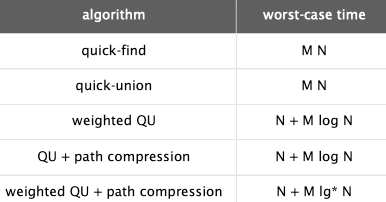Topic 1 - Union Find
Union Find1 Dynamic Connectivity¶
The graph connectivity problem is the following: Given an undirected graph G, preprocess the graph so that queries of the form “are nodes u and v connected?”
Connected components: Maximal set of objects that are mutually connected.
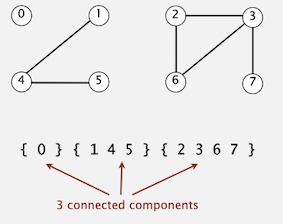
Union-Find data type (API)¶
Union-Find(并查集) API:
- the
union() operation merges two components if the two sites are in different components. - the
find() operation returns an integer component identifier for a given site. - the
connected() operation determines whether two sites are in the same component. - the
count() method returns the number of components.

2 Quick-Find¶
Quick-Find Idea: all sites in a component must have the same value in id[].

This method is called quick-find because
public class QuickFind {
private int[] id;
public QuickFind(int N) {
id = new int[N];
// set id of each object to itself
for (int i = 0; i < N; i++) id[i] = i;
}
public boolean connected(int p, int q) {
return id[p] == id[q];
}
public int find(int p) {
return id[p];
}
public void union(int p, int q) {
int pid = id[p];
int qid = id[q];
// change all entries with id[p] to id[q]
for (int i = 0; i < id.length; i++)
if (id[i] == pid) id[i] = qid;
}
}
Analysis¶
The Quick-Find algorithm uses one array access for each call to

WORST CASE: suppose we wind up with a single component. This requires at least N-1 calls to
3 Quick-Union¶
Data structure:
- Interpretation: id[i] is parent of i.
- Root of i is id[id[id[...id[i]...]]] (keep going until it doesn’t change)
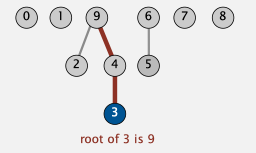
Specifically, the id[] entry, for each site is the name of another site in the same component (possibly itself) — we refer to this connection as a link. To implement
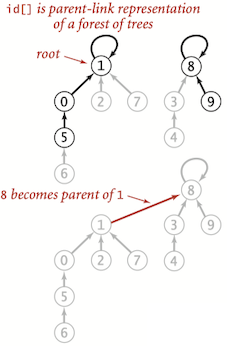
public class QuickUnion {
private int[] id;
private int count;
public QuickUnion(int N) {
count = N;
id = new int[N];
// set id of each object to itself (N array accesses)
for (int i = 0; i < N; i++) id[i] = i;
}
private int find(int p) {
// chase parent pointers until reach root
while (p != id[p]) p = id[p];
return p;
}
public boolean connected(int p, int q) {
//check if p and q have same root
return find(p) == find(q);
}
public void union(int p, int q) {
// change root of p to point to root of q
int i = find(p);
int j = find(q);
id[i] = j;
count--;
}
}
Analysis¶
The number of array accesses used by
WORST CASE: suppose we wind up with a single component, the running time is quadratic.

4 Improvement 1: weighting¶
Weighted quick-union: Rather than arbitrarily connecting the second tree to the first for
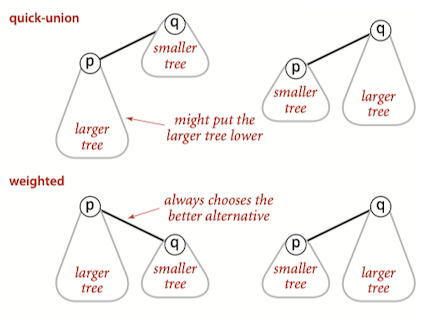
public class WeightedQuickUnion {
private int[] id; // parent link (site indexed)
private int[] sz; // size of component for roots (site indexed)
private int count; // number of components
public WeightedQuickUnion(int N) {
count = N;
id = new int[N];
for (int i = 0; i < N; i++) id[i] = i;
sz = new int[N];
for (int i = 0; i < N; i++) sz[i] = 1;
}
public int count() {
return count;
}
public boolean connected(int p, int q) {
return find(p) == find(q);
}
private int find(int p) { // Follow links to find a root.
while (p != id[p]) p = id[p];
return p;
}
public void union(int p, int q) {
int i = find(p);
int j = find(q);
if (i == j) return;
// Make smaller root point to larger one.
if (sz[i] < sz[j]) {
id[i] = j; sz[j] += sz[i];
} else {
id[j] = i; sz[i] += sz[j];
}
count--;
}
}
Analysis¶
The depth of any node in a forest built by weighted quick-union for N sites is at most \log N.
The worst case for weighted quick union is when the sizes of the trees to be merged by
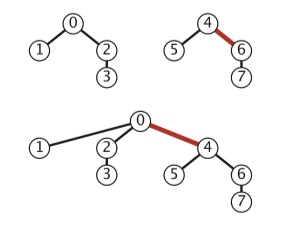
For weighted quick-union with N sites, the worst-case order of growth of the cost of
Specifically, the weighted quick-union algorithm uses at most cM\log N array accesses to process M connections among N sites for a small constant c.

5 Improvement 2: Path Compression¶
IDEA: Just after computing the root of p, set the id of each examined node to point to that root.
Two-pass implementation: add second loop to
Simpler one-pass variant: Make every other node in path point to its grandparent (thereby halving path length).
private int find(int p) { // Follow links to find a root.
while (p != id[p]) {
// only one extra line of code !
id[p] = id[id[p]];
p = id[p];
}
return p;
}
Amortized Analysis¶
Starting from an empty data structure, any sequence of M union-find ops on N objects makes \le c ( N + M \lg^*N ) array accesses, where lg^* is iterated logarithm[wiki, 迭代对数]. (lg^*N表示将N变为小于1需要的\log迭代次数)
Summary¶
M union-find operations on a set of N objects:
